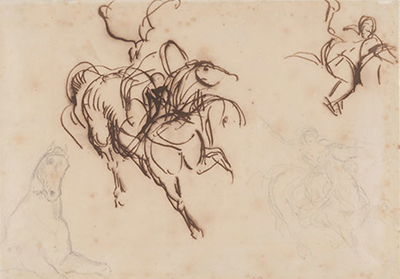Heliodorus Driven from the Temple was one of Eugene Delacroix's most complex paintings and so required considerable amounts of preparation prior to commencing the work proper. The drawing found here focuses on the main character, horse and rider.
The drawing found here which features several different compositions together on the same sheet is dated at around 1849-1850, with the completed painting coming at some point between the years of 1854 and 1861. He was initially inspired by the work of Raphael who completed a painting on this theme many centuries earlier as he was already well acquained with the work of this late Renaissance master, having actually described his drawings as approaching perfection. Despite never having studied in Italy, he was very familiar with the work of the Renaissance and Baroque eras and was able to see some of it in person within the impressive collections of various French art institutions. He would look to Titian for ideas regarding the techniques of portraiture, for example.
Within this single page there are several items to study. Firstly the horse with a loose outline of the rider, with a further more detailed take on the rider alongside. There are then fainter touches of pen which go into detail on the front of the horse as well as considering the overall horse and rider together in greater detail. It is clear that Delacroix understood the challenges of portraiture and figurative art, regularly practicing and copying existing prints from other artists from a young age in order to allow him to complete these types of tasks without too much concentration on technical matters - instead he could work from memory and therefore focus more on his creativity and expression. In other examples of his drawings he would first use pen strokes as these to lay out the rough shapes and forms before adding thicker brush strokes that would apply a darker contrast.
The final piece was installed at the Chapel of the Holy Angels in the Parisian church of Saint-Sulpice. Movement was key to the whole painting and so it was not simply a case of depicting horse and rider, but also considering their movement in relation to the other elements of the scene. Across the background of the completed painting there are also many more figures set within a stunning and highly detailed series of architectural elements which set this painting out as amongst his finest of all. Perhaps it was this heavy attention to preparation that ensured such a high quality final work, though he would normally follow this path of process on his other major works as well.




